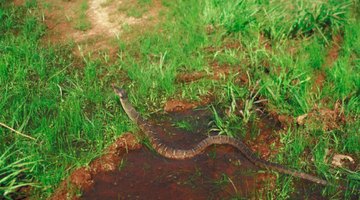How to Get Rid of Nostoc Algae
Those firm, gelatinous balls on the soggier parts of your property are Nostoc algae. Nostoc algae thrives in over-watered or consistently moist, sunny areas. Although it is not hazardous to plants or animals, it is terribly unattractive. There are several ways to combat a Nostoc algae problem.

Chemical control options provide a quick fix, but cultural control is the most reliable way to win the long-term battle against Nostoc algae.
Things You Will Need
- Sand
- Fungicide
-
Raise the grade in affected areas, and increase drainage by mixing a 3- to 4-inch layer of sand into the top 6 to 8 inches of the soil. Nostoc algae needs standing water and consistent moisture to thrive. The sand will allow the water to filter down to lower levels of the soil where Nostoc algae will not grow.
-
Assess your plant's water needs. Over-watering is a common cause of Nostoc algae proliferation. Most garden and lawn plants only need 1 inch (2 in hot, dry weather) of water during weeks in which there has been no rain. Watering daily and/or watering so much that puddles form on the soil surface is not only bad for most plants, but leads to the proliferation of fungi and algae like Nostoc.
-
Assess your garden or lawn's fertilization needs. High phophorous levels in the soil, due to overfertilization or fertilizer or manure runoff from neighboring areas, can lead to the proliferation of Nostoc algae. Before you fertilize your lawn or garden, test the soil (through your local county extension office or with a home test kit available at most home and garden centers). The results will tell you exactly how much fertilizer is necessary for your land. Do not exceed these amounts.
-
Apply a fungicide. Cultural controls are not suitable for every area. And even in suitable areas, chemical control can get rid of the initial infestation while you work on preventing the problem from recurring. Dr. Phillip Colbaugh, turfgrass pathologist writing for GroundsMaintenance.com, recommends applying a chlorothalonil or mancozeb-based fungicide to the infested area once every seven to 14 days until the Nostoc is killed (usually two to three rounds of application will do it). Follow the manufacturer's instructions, and apply the fungicide at the lowest application rate for newly established infestations. Tackle thick mats of Nostoc algae with the highest listed application rate. These fungicides work best if the ground is as dry as possible at the time of application. If cultural moisture control is not an option, continued application every 14 days at the lowest application rate may prevent another infestation from occurring.
The Drip Cap
- Those firm, gelatinous balls on the soggier parts of your property are Nostoc algae.
- Assess your plant's water needs.
- High phophorous levels in the soil, due to overfertilization or fertilizer or manure runoff from neighboring areas, can lead to the proliferation of Nostoc algae.
- Do not exceed these amounts.
- Follow the manufacturer's instructions, and apply the fungicide at the lowest application rate for newly established infestations.
References
Writer Bio
Based in Houston, Texas, Meg Butler is a professional farmer, house flipper and landscaper. When not busy learning about homes and appliances she's sharing that knowledge. Butler began blogging, editing and writing in 2000. Her work has appered in the "Houston Press" and several other publications. She has an A.A. in journalism and a B.A. in history from New York University.
Photo Credits
- Jupiterimages/Photos.com/Getty Images
- Jupiterimages/Photos.com/Getty Images
More Articles



